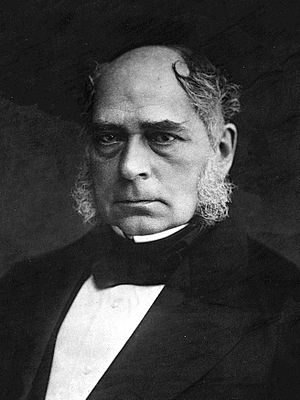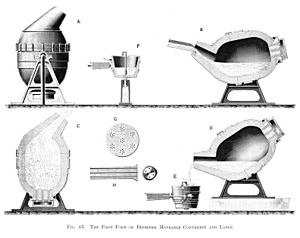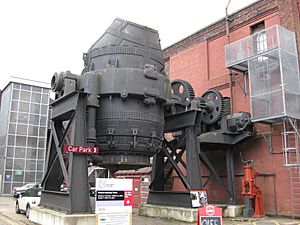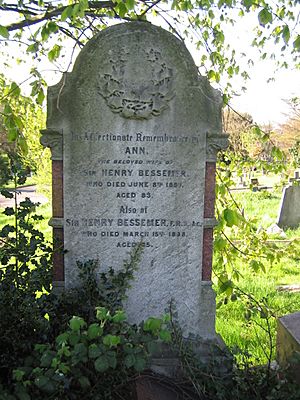Henry Bessemer facts for kids
Quick facts for kids
Henry Bessemer
|
|
|---|---|

Bessemer c. 1890s
|
|
| Born |
Henry Bessemer
19 January 1813 Charlton, Hertfordshire, England
|
| Died | 15 March 1898 (aged 85) London, England
|
| Nationality | English |
| Citizenship | British |
| Occupation | Engineer and inventor |
| Known for | Development of the Bessemer process for the manufacture of steel |
| Awards | Albert Medal (1872) |
| Signature | |
Sir Henry Bessemer FRS (born January 19, 1813 – died March 15, 1898) was an English inventor. His amazing steel-making process became the most important way to make steel for almost 100 years. This was from 1856 to 1950. He also helped make the town of Sheffield, known as 'Steel City,' a huge industrial center.
Bessemer wanted to make steel cheaper for army weapons. He invented a system to blow air through hot, melted iron. This removed bad stuff from the iron. This made steel easier, faster, and much cheaper to produce. It completely changed how buildings and machines were made.
He was one of the most important inventors of the Second Industrial Revolution. Bessemer also created over 100 other inventions. These were in areas like iron, steel, and glass. Unlike many inventors, he was able to make his ideas work and earn a lot of money from them. He was made a knight in 1879 for his contributions to science. In the same year, he became a member of the Royal Society.
Contents
Meet Henry Bessemer's Father
Henry Bessemer's father, Anthony Bessemer, was born in London. His family were Huguenots, who were French Protestants. Anthony moved to Paris when he was about 21 years old. He was also an inventor.
While working for the Paris Mint (where money is made), he created a machine. This machine could make steel molds for medallions from a bigger model. He became a member of the French Academy of Science when he was 26. This was because he made improvements to the optical microscope.
He had to leave Paris because of the French Revolution. He then returned to Britain. There, he invented a way to make gold chains. This invention was very successful. It allowed him to buy a small property in the village of Charlton. Henry was born there, near Hitchin in Hertfordshire. Henry Bessemer said he was named by his godfather, Henry Caslon. Caslon hired his father as a punchcutter, someone who makes metal stamps for printing.
Henry's First Inventions
Bessemer made his first fortune from an invention that helped make gold paint. He created six steam-powered machines to make bronze powder. This powder was used to make gold paint.
In his autobiography, he wrote about how he studied bronze powder from Nuremberg. At that time, Nuremberg was the only place that made it. He then copied and made the product even better. He set up a simple production line to make it. This was an early example of reverse engineering. This is when you take a product apart to see how it works, then make your own version.
The process was kept secret. Only his close family members could go into the factory. The Nuremberg powder was made by hand. It sold for a very high price in London. Bessemer eventually lowered the price a lot, making it much more affordable. The money he earned from selling this paint allowed him to work on his other inventions.
In 1848, Bessemer patented a way to make a continuous sheet of plate glass. However, this invention did not make money. But, he learned a lot about designing furnaces. This experience was very useful for his new steel-making process.
The Amazing Bessemer Process
Henry Bessemer worked on making cheap steel for guns from 1850 to 1855. Then, he patented his new method.
On August 24, 1856, Bessemer first explained his process. He spoke at a meeting of the British Association in Cheltenham. He called his talk "The Manufacture of Malleable Iron and Steel without Fuel." The full speech was printed in The Times newspaper.
The Bessemer process involved blowing oxygen-rich air through melted pig iron. This burned away the impurities. This process then created steel. James Nasmyth had been working on a similar idea before Bessemer. Nasmyth was not keen on getting patents. He was also still working out some problems with his method. After hearing Bessemer's talk, Nasmyth stopped his project. Bessemer recognized Nasmyth's efforts. He offered him a share of his patent's value. But Nasmyth was about to retire, so he turned it down.
Many industries needed steel but only had cast iron and wrought iron. For example, railway bridges and tracks were often made of cast iron. Cast iron was very risky. Many engineers knew how dangerous it could be. There were many accidents when cast iron beams suddenly broke. This happened at the Dee Bridge disaster in 1847 and the Tay Bridge disaster in 1879. These failures continued until all cast iron bridges were replaced with steel structures. Wrought iron structures were much safer and rarely failed.
The Bessemer process is not used much today. But when it was invented, it was incredibly important for industry. It made steel much cheaper to produce. This led to steel being used instead of cast iron and wrought iron everywhere. Bessemer started working on steel because he wanted to make better guns.
How the Bessemer Process Was Used
Bessemer allowed five ironmasters (people who run iron factories) to use his patent. But at first, these companies found it very hard to make good steel. Mr. Göran Fredrik Göransson, a Swedish ironmaster, was the first to make good steel using the process. He used purer charcoal pig iron from his country. But even he had to try many times.
His success made Bessemer try a purer iron from Cumberland. But even with this, he had trouble. It was hard to control the amount of carbon in the steel. Robert Forester Mushet had done thousands of experiments. He found that you could control the carbon. You remove almost all of it from the iron. Then, you add a precise amount of carbon and manganese. This is done using a material called spiegeleisen. This made the finished steel much better and easier to shape.
When Bessemer tried to get other makers to use his improved system, they refused. So, he decided to use the process himself. He opened steelworks in Sheffield with business partners. One of them was W & J Galloway & Sons. They started making steel. At first, they didn't make much. But slowly, their operations grew. Soon, Henry Bessemer & Co. was selling steel for much less than other companies. This made other steel traders pay attention. They started asking for licenses to use Bessemer's process. He earned over a million pounds in royalties from these licenses.
However, Mushet, who helped improve the process, received nothing. By 1866, he was poor and sick. In that year, his 16-year-old daughter, Mary, traveled to London alone. She went to Bessemer's office. She told him that his success was based on her father's work. Bessemer decided to pay Mushet a yearly pension of £300. This was a lot of money. He paid it for over 20 years. He probably did this to stop the Mushets from taking legal action. Bessemer also had factories in Greenwich, London, near the River Thames, starting around 1865.
A historian named W. M. Lord said that Sir Henry Bessemer was special. He developed his invention from an idea to a working product in his own lifetime. He was also a good businessman and made money from it. Many inventors don't see their ideas fully developed or profit from them.
Other Cool Inventions
Bessemer was a very busy inventor. He held at least 129 patents from 1838 to 1883. These inventions included military weapons and movable stamps for postage. He also invented a screw machine to get sugar from sugar cane. Many other inventions were in the fields of iron, steel, and glass. You can read about them in his autobiography.
In 1868, he felt very seasick. So, he designed the SS Bessemer (also called the "Bessemer Saloon"). This was a passenger steamship with a special cabin. The cabin was on gimbals. This meant it was designed to stay level, no matter how rough the sea was. The idea was to stop passengers from getting seasick. The system worked in a model and in a test version built in his garden. But it never got a real test at sea. On its first trip, the ship crashed into part of the Calais pier. Investors lost faith, and the ship was taken apart.
Continuous Casting
Bessemer also got a patent in 1857 for casting metal between two spinning rollers. This was an early version of today's continuous casting processes. It's amazing that Bessemer's original idea is still used today for making steel strips.
His Final Years
Bessemer passed away in March 1898 in Denmark Hill, London. He is buried in West Norwood Cemetery in London. Other important Victorians like Sir Henry Tate and Sir Henry Doulton are also buried there.
Honors and His Legacy
Queen Victoria made Bessemer a knight on June 26, 1879. This was for his important work in science. In the same year, he became a member of the Royal Society. The Institution of Engineers and Shipbuilders in Scotland made Bessemer an honorary member in 1891. In 1895, he was chosen as a Foreign Honorary Member of the American Academy of Arts and Sciences.
Sheffield's Kelham Island Industrial Heritage Museum has an early example of a Bessemer converter. You can go and see it there. A school in Hitchin was named after him. When the school was torn down in the 1980s, the new road built there was named Bessemer Close in 1995. Bessemer Way in Rotherham is also named in his honor. In 2009, a pub in Sheffield was renamed "The Bessemer." This was to honor Henry Bessemer, who had a huge impact on the city's development. In Workington, Cumbria, a local pub is also named after him.
In 2002, the Institute of Materials, Minerals and Mining (IOM3) was formed. It included older groups like the Iron and Steel Institute. Bessemer was the president of the Iron and Steel Institute from 1871 to 1873. This group started the Bessemer Gold Medal. Today, IOM3 still gives out this medal every year. It's for amazing work in the steel industry.
In 2003, Bessemer was named among the top 10 technology innovators in a book called Human Accomplishment: The Pursuit of Excellence in the Arts and Sciences, 800 B.C. to 1950. Many English engineers felt sad that a man who did so much for industry didn't get more recognition from his own government. They pointed out that in the United States, where the Bessemer process was used a lot, eight cities or towns were named after him.
See also
 In Spanish: Henry Bessemer para niños
In Spanish: Henry Bessemer para niños





